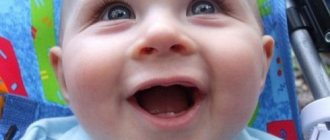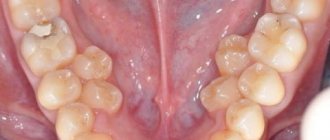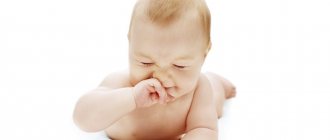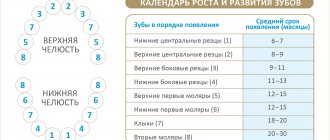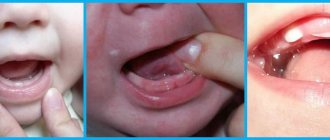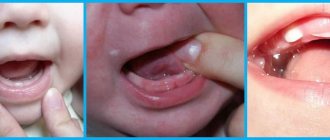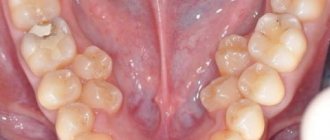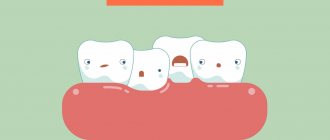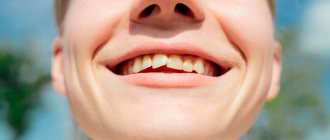The formation of teeth is a complex step-by-step process that begins in the first weeks of intrauterine life. Thus, by the time of birth, the baby has the rudiments of 20 primary and 16 permanent teeth inside each jaw. But, like all stages of development, teething in children under one year and older occurs differently. Some endure this period relatively calmly, others are capricious and sleep poorly. Why this happens and how to understand that the baby is cutting teeth, we will tell you further.
Timing of teething in children
On average, the first teeth in healthy children appear at 5–6 months. But sometimes it happens that someone has a white bump visible at 4 months, and someone smiles with a toothless mouth even at 8-12 months. And this is not a deviation from the norm. According to studies by a number of authors, the timing differs depending on the region of residence, race, and gender of the child. For example, children in the southern regions develop teeth a little earlier than those in the north. The formation of temporary teeth is also influenced by the following factors:
- heredity;
- maternal toxicosis in the second and third trimester of pregnancy;
- prematurity;
- artificial feeding;
- quality of drinking water;
- hypothyroidism and other endocrine pathologies;
- infectious diseases;
- weakened immunity;
- rickets.
It is impossible to speed up the timing and influence the sequence of teething in children. The only thing parents can do at this time is to alleviate the baby’s condition if he is restless and in pain (more on this below).
Reasons for violation
The lower and upper teeth are formed in children at different times. The main factor that influences this is heredity, that is, the predisposition is laid down in genes, as is the quality of dentin, as well as the enamel layer. If mom or dad, grandfather or grandmother, or other relatives had cases of deviation from the order of appearance of chewing organs, this can be inherited by the toddler. Therefore, the child’s teeth grow out of order.
Of course, relatives are always worried when the growth process is delayed and goes astray from the generally accepted schedule. But dentists say that non-standard situations are also normal:
- When the appearance of units occurs several months earlier or later;
- If the order of appearance of the masticatory organs is disrupted;
- When the rate of growth of units does not coincide with the announced scheme;
Since the process of growth of incisors, canines, and molars begins at 12 weeks of pregnancy, it is influenced by the health of the mother. Influenza, bad habits of the mother in labor, and infectious diseases have a negative impact. Artificial feeding has a bad effect on the newborn's body. After all, sucking the mother's breast actively develops the facial muscles, and the correct development of the lower jaw occurs. Sucking from bottles occurs only with the help of the lips. As a result, the first tooth may appear in the top row. In this case, therapy is not needed. It is important that all 20 time units appear.
Remember! Medicine does not know of cases where children were left without chewing organs due to their untimely appearance. The units will appear, you just need to wait.
It wouldn't hurt to go to the dentist. If necessary, bite correction in children is carried out. In addition, a non-standard order can be observed in babies if their parents are of different nationalities, or if the climate is not suitable for the newborn. Many parents see disordered teething as a sign of rickets. Doctors explain that with rickets, babies have a large head, protruding ribs, and excessive sweating. If the pediatrician does not find these signs, then there is no reason to worry. But sometimes the absence of the first units up to a year indicates:
- Vitamin D deficiency in the body;
- Violation of metabolic processes;
- Gastrointestinal problems;
- Chronic diseases;
- Infectious diseases such as measles, scarlet fever;
- Lack of rudiments of future chewing organs;
- Horizontal position of the unit in the gum;
- Bite abnormalities;
- Dysfunction of the endocrine gland system;
- Slow development of the body;
Diagnosis and consultation with a pediatrician or pediatric dentist will clarify the situation and eliminate the problem.
Subsequence
The order in which teeth appear may vary, which is rare and is not considered pathological. For some boys and girls, the upper incisors appear first, rather than the lower incisors as usual. But basically the sequence of teething in children is as follows (teeth appear in pairs):
- lower central incisors;
- upper central incisors;
- upper lateral incisors;
- lower lateral incisors;
- first upper molars (molars);
- first lower molars;
- upper canines;
- lower canines;
- second lower molars;
- second upper molars.
By the age of 2.5–3 years, the child has a full set of baby teeth: 10 on each jaw. After about 4–6 years, the roots begin to dissolve, the teeth lose support and fall out in the same order in which they erupted.
As the jaw and facial bones grow, spaces form between the primary teeth. This provides space for permanent, larger teeth to emerge, which erupt from 5 to 15 years of age.
First teeth
When to expect
The baby's milk teeth are formed at the 7th–8th week of intrauterine development, and the permanent ones at the end of the 4th month of pregnancy. In total, a child develops 20 baby teeth, while 32 permanent teeth. To provide the baby with a Hollywood smile, the expectant mother needs to eat properly throughout the nine months of pregnancy. There are no calcium preparations that are 100% absorbable, so it is very important to get “natural” calcium from food, especially cottage cheese. And, of course, the pregnant woman herself needs to have all her teeth treated - now there are very gentle technologies for this.
The eruption of the first milk teeth in most cases begins at 3–8 months of the baby’s life and ends closer to three years. But it also happens that children are born with one or two teeth, or teeth may erupt in the first weeks of life. Often the timing of teething depends on genetic characteristics, but much more strongly on other factors. Diseases of the baby also affect the teeth (for example, with rickets, frequent ARVI and dyspepsia, teeth erupt later). It’s worth paying attention to the nature of your diet, the quality of drinking water, even the climate! On average, northern residents start teething a little later than southerners. Sometimes teething is delayed, and the first tooth appears closer to a year. Usually there is nothing wrong with this. It is believed that it is not so much the timing that speaks about a child’s health, but rather the order in which teeth erupt. If it is broken, pay attention to this fact and show the baby to the pediatric dentist.
The process has started
The fact that the teething process has begun is indicated by profuse salivation. In addition, the baby begins to put into his mouth everything that comes to hand. This means that the gums are itchy, causing him discomfort. Trying to relieve the itching, the baby instinctively acts correctly - micromassage of the gums improves microcirculation in them, teeth erupt easier and faster. During this period, provide your child with teethers: hypoallergenic silicone toys filled with water. The teether should not be cooled in the freezer - only in the refrigerator: otherwise the baby will get hurt on a hard surface. If the gums are very swollen and the baby is crying in pain, use special dental gels that have a mild local anesthetic effect.
For most children, the teething process goes quite smoothly. There may be short periods of anxiety, disturbances in daily routine and nutrition. Sometimes even teething is accompanied by diarrhea, runny nose, cough and fever. And during the period when teeth appear, the baby is vulnerable to all kinds of infections. The baby’s immunity is weakening these days, and it is easier for him to “catch” the virus, so you should not attribute the deterioration of the condition only to the teeth. If a child has a fever when a tooth is being cut, you need to look for another inflammatory source in the body.
At 6 months
The baby usually boasts central lower incisors. This is a reason to start brushing your teeth. Why so early? Baby teeth are small and sharp, have an uneven wavy edge, stand close to each other and, as a rule, have a yellowish tint. These teeth have a low degree of mineralization. Their enamel and dentin are very thin. All this contributes to the rapid occurrence and spread of caries. In order to prevent it, you need to regularly brush your teeth: for this you can use various massage brushes, which not only accustom the child to hygiene, but also facilitate the teething process itself. We immediately teach you how to brush your teeth correctly - from the gums to the edges, with slightly “sweeping”, semicircular movements, and in no case horizontally. If possible, brush your teeth after every meal (and at least twice a day). Isn't there such a possibility? Give the baby something to drink - the water will wash away any remaining food.
At 8 months
The upper central incisors usually erupt.
At 9 months,
the upper lateral incisors appear.
At 11 months,
many children's lower lateral incisors are already in place!
By the age of one year, a baby normally already has eight teeth
.
But there may not be any - delayed teething occurs in 25% of cases with normal psychomotor development of the child. In extremely rare cases, the absence of teeth is associated with adentia - the absence of their rudiments. This can be checked by a pediatric dentist using radiovisiography. By 13–15 months,
the upper first molars appear first, followed by the lower ones.
From the age of one year, your baby can brush his teeth with children's toothpaste and a special children's brush. The service life of the brush is no more than 2 months, even if it looks like new. Many kids swallow the tasty pasta. There is no need to be afraid of this if it is for children and its quantity is no more than a pea. Of course, until 2–2.5 years of age, teeth brushing should be done with the help and then under the watchful supervision of the mother.
At 18 months
fangs erupt.
Typically, these teeth cause more problems than others; their eruption is more painful, and this process is often accompanied by discomfort. At 20 months,
the second molars erupt.
And sometimes already at this age the mother can notice the first problems. Doctors reassure: carious baby teeth are not a reason to worry that permanent teeth will also be bad. As practice shows, there is no pattern here. Of course, if parents do not neglect disease prevention and dental hygiene. At 2.5 years old, a child normally has a full set of baby teeth.
There are 20 of them - 10 on each jaw .
Baby teeth don’t last very long – soon they will begin to fall out and permanent ones will appear in their place. Usually the change of teeth begins at about 5–6 years and lasts until the age of 20, when wisdom teeth erupt.
Starting from 6 months, you must come for a preventive examination twice a year. When this becomes a habit, the baby will not be afraid of doctors, and by the age of 7–8 years (when a visit to the clinic can no longer be avoided) he will sit completely calmly in the dental chair
In order for your baby’s teeth to grow strong and healthy, you need to start taking care of them almost before conception. It’s also better to meet the dentist early
Timing of eruption and loss of baby teeth
| Upper teeth | |||
| Tooth name | Period of eruption | Teething order | Drop date |
| Central incisor | 8 months – 1 year | 2 | 6–7 years |
| Lateral incisor | 9 months – 1 year 2 months | 3 | 7–8 years |
| Fang | 1 year 3 months – 1 year 10 months | 7 | 10–12 years |
| First molar | 1 year – 1 year 6 months | 5 | 9–11 years |
| Second molar | 2 years – 2 years 8 months | 10 | 10–12 years |
| Lower teeth | |||
| Central incisor | 6 months –10 months | 1 | 6–7 years |
| Lateral incisor | 10 months –1 year 4 months | 4 | 7–8 years |
| Fang | 1 year 4 months – 2 years | 8 | 9–12 years |
| First molar | 1 year 2 months – 1 year 7 months | 6 | 9–11 years |
| Second molar | 1 year 10 months – 2 years 8 months | 9 | 10–12 years |
Symptoms
Usually, no serious problems arise during teething, but local (in rare cases systemic) disturbances are present. These include:
- swelling and soreness of the gums;
- profuse drooling;
- irritability;
- restless sleep;
- lethargy;
- the baby's need for biting and chewing;
- poor appetite.
Loose stools, low-grade fever and runny nose are less common than the above symptoms.
Important! If the body temperature rises above 38 degrees, convulsions, difficulty breathing, you need to show the baby to a doctor and call an ambulance. This may indicate a viral infectious disease and is not a sign of teething.
Some parents wonder why this process occurs differently in babies. For example, in some teething occurs with fever, in others it does not. It is noted that, among other factors, this is also influenced by the child’s constitutional type. In children of the allergic type, this period may be accompanied by increased moodiness, atopic dermatitis, and ARVI is often associated. Infants with asthenic syndrome sleep poorly, refuse to eat, and cry for a long time due to severe pain.
What is milk bite? Formula
The appearance of baby teeth is a signal that the baby is growing up. From the point of view of human development, their appearance indicates the following:
- The child is ready for the transition from sucking to chewing, that is, from mother’s milk (or formula) to complementary foods and a gradual transition to normal food.
- From the intuitive production of individual sounds, the baby moves on to understanding speech addressed to him and even tries to imitate it.
The rudiments of baby teeth are formed in the womb, so the woman’s condition during the first trimester of pregnancy is responsible for the predisposition to “bad teeth”.
How many baby teeth should children have? The temporary bite has 20 teeth, of which 8 are incisors, 4 canines and 8 molars.
In dentistry, there are several ways to designate a temporary occlusion. In ordinary life, this information is unlikely to be useful to the mother, but it can help to better understand the dentist’s explanations and actions during the appointment.
- The classical Zsigmond-Palmer system, which was adopted for a long time in the USSR. In it, the milk row was designated with Roman numerals.
- A modern system accepted throughout the world, including by the International Dental Association. It involves using two numbers to designate each tooth. The first number indicates the quadrant in which the tooth is located (upper left or lower right), and the second number indicates the serial number of the tooth itself.
- An alphanumeric system in which each type of baby tooth is designated by a capital letter, and the index number is a serial number. This method is very convenient to indicate a changeable bite. To do this, you just need to replace lowercase letters with capital ones. This change is immediately noticeable.
- In America, it is customary to designate baby teeth using the letters of the English alphabet, placing them from the upper right molar to the lower right.
- You can also find the group designation of milk occlusion. In it, the number indicates the number of teeth of a certain group, and its location, in fact, the type of tooth.
- Similarly, temporary occlusion can be recorded using an alphanumeric system.
How does the jaw of baby teeth differ from permanent teeth?
There is an opinion among parents that baby teeth grow without roots. This myth appeared because during a change in bite, teeth fall out with reduced (resolved) roots. In fact, baby teeth have roots, and their number completely corresponds to that of permanent teeth. Despite the fact that the teeth of the temporary and permanent dentition are similar in appearance, there are several differences between them that help dentists accurately determine the group affiliation of the tooth.
| Milk bite | Permanent bite | |
| Number of teeth | 20 | 32 |
| Premolars | No | There is |
| Color | White-blue | Yellowish |
| Size | Small | Big |
| Crown sizes | The crown is wider than it is tall | High crown |
| Crown to root size ratio | The crown is more convex, making the roots appear smaller | Traditional ratio of crown to root sizes. |
| Presence of enamel roller | In the area of the neck of the tooth there is a thickening of the enamel, due to which the crown becomes larger. | No |
| Degree of mineralization | Low | High |
| Cavity dimensions | Extensive | Standard sizes |
| Channels | Wide canals and apical foramina | Narrow, sometimes difficult to pass with irregularly shaped branches |
| Root shape | Rounded | Long and elongated |
| Direction of root growth | Moved to the side to make room for the permanent tooth germ | Perpendicular to the jaw bone |
| Root reduction | Eat before changing bite | No |
| Tremas and diastemas (distance between teeth) | Normal physiological state as the jaw grows (from 4 to 6 years) | It shouldn't be normal. |
| Lumps and cutting edges | By the time the bite changes, they are erased (by 6 years) | Well expressed throughout life |
How to help your baby teething
To eliminate unpleasant symptoms and make the child feel better, parents are advised to:
- Buy teethers made of silicone or special soft plastic filled with water. These devices are cooled to a comfortable temperature (not frozen) and given to the baby. Cold reduces pain in the gums and relieves swelling.
- Massage your gums. To do this, an adult needs to wrap his finger in a clean gauze swab, moisten it in cool boiled water and lightly massage the inflamed area.
- Give ibuprofen or paracetamol if the child is very restless or has a high fever. The dosage is prescribed by the doctor.
Important! During teething, babies put everything in their mouth, which can cause a secondary infection. Therefore, parents need to carefully monitor oral hygiene, regularly wipe their face with a clean towel, and gently blot saliva.
As for special gels for gums, you need to be careful and not use them too often, as some components can cause an allergic reaction.
Caring for baby teeth
You need to take care of your teeth immediately after teething. Moms do it first. For adults, special finger brushes have been created that are convenient for cleaning teeth from plaque, but so far without toothpaste. When the baby learns to rinse his mouth and spit, they move on to brushing with children's toothpaste without fluoride (this can be done earlier if the tube indicates that the toothpaste is from 0 years). So, gradually, the child will form a useful habit of caring for the oral cavity.
Another important reason for caring for teeth from infancy is that it affects the formation of permanent teeth and bite. For example, caries of a temporary tooth can transfer to the germ of a permanent one. And early loss (before 5 years) of a baby tooth will lead to uneven dentition in the future. If the molar does not begin to grow in time, the adjacent baby teeth will move and fill the resulting space.
Causes for concern
When a child remains without teeth after turning one year old, parents should take him to the doctor. Of course, the time at which chewing organs appear may vary. For example, in boys this process occurs more slowly than in girls. But, there are situations when medical consultation is absolutely necessary.
- An urgent visit to a pediatrician is necessary at a high temperature of more than 39 degrees.
- The baby should be shown to a doctor if symptoms such as frequent diarrhea and vomiting develop.
- An orthodontist is consulted if a malocclusion is suspected. Perhaps, after the eruption of incisors, canines, and molars, he needs therapy. In such situations, braces are used for children while the jaw apparatus is pliable.
- A specialist should examine a newborn whose units appeared in the prenatal period.
- A dentist is consulted if the organs are not formed in the dentition.
Therapy may consist of strengthening the health of the toddler, performing special exercises, and massaging the gums.
